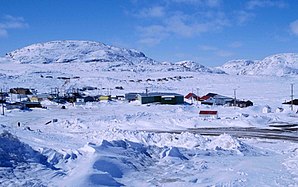Cape Dorset
| Cape Dorset | ||
|---|---|---|
 Early spring in Cape Dorset (part of the settlement against the characteristic backdrop of the approximately 220 meter high Kinngait) |
||
| Location in Nunavut | ||
|
|
||
| State : |
|
|
| Territory : | Nunavut | |
| Region: | Qikiqtaaluk | |
| Coordinates : | 64 ° 14 ′ N , 76 ° 32 ′ W | |
| Residents : | 1300 (as of:) | |
 West Baffin Eskimo Co-operative Cape Dorset building that produces Inuit art prints; in the background: neighboring island Mallikjuaq |
||
Cape Dorset (called by the Inuit Kinngait , high mountains) is an Inuit settlement with around 1,300 inhabitants in the Canadian territory of Nunavut . It is located about 450 km west of Iqaluit on a small island of the same name, off the Foxeh peninsula (southwestern part of Baffin Island ).
history
Cape Dorset gave its name to an entire culture, the Dorset culture , when the anthropologist Diamond Jenness successfully crowned his search for a lost Paleo-Eskimo culture there in 1925 and was able to prove that the region has been inhabited for thousands of years.
The Hudson's Bay Company established a trading post here in 1913. In 1938 a Roman Catholic Church was established (abandoned again in 1960) and an Anglican Church in 1953. The first school and the first infirmary were established in 1950. The actual construction of the settlement began in the early 1950s.
Culture
Cape Dorset is of exceptional importance in the field of Inuit art ("Inuit Art Capital", capital of Inuit art). The foundation for this was laid by James and Alma Houston, who settled here for a decade in 1951 and recognized the unusually great potential for artistic talent and creativity among the Inuit. They encouraged the creation of expressive sculptures. The raw materials used include serpentine ("serpentine stone", steatinite) and serpentinite (serpentine slate) as well as dolomite (calcium-magnesium-carbonate), quartz (silicon dioxide) and other types of stone such as marble (calcium carbonate), rarely steatite which is too soft for artistic figures ( "Soapstone"). Most of the material comes from quarries at Andrew Gordon Bay on the north bank of Hudson Strait. Above all, however, the Houstons introduced European stone printing techniques (lithography, stone carving, aquatint etching). The center was the West Baffin Eskimo Co-operative , headed from 1962 to the turn of the millennium by Terry Ryan as James Houston's successor .
From Cape Dorset you can walk at low tide, otherwise by boat and in winter by snowmobile to the neighboring island of Mallikjuaq (translated: "big wave"), on which the Mallikjuaq Territorial Historical Park is located with a variety of relics from the Thule - and also the Dorset period is located.
Trivia
In Frank Schätzing 's world bestseller Der Schwarm , Cape Dorset is mentioned as the hometown of whale specialist Leon Anawak .
literature
- Miriam Dewar (Ed.): The Nunavut Handbook: Traveling in Canada's Arctic . Ayaya Marketing & Communications, Iqaluit / Ottawa 2004, ISBN 0-9736754-0-3 (English).
- Ansgar Walk: Kenojuak - Life story of an important Inuit artist , Bielefeld 2003 ISBN 3-934872-51-4


